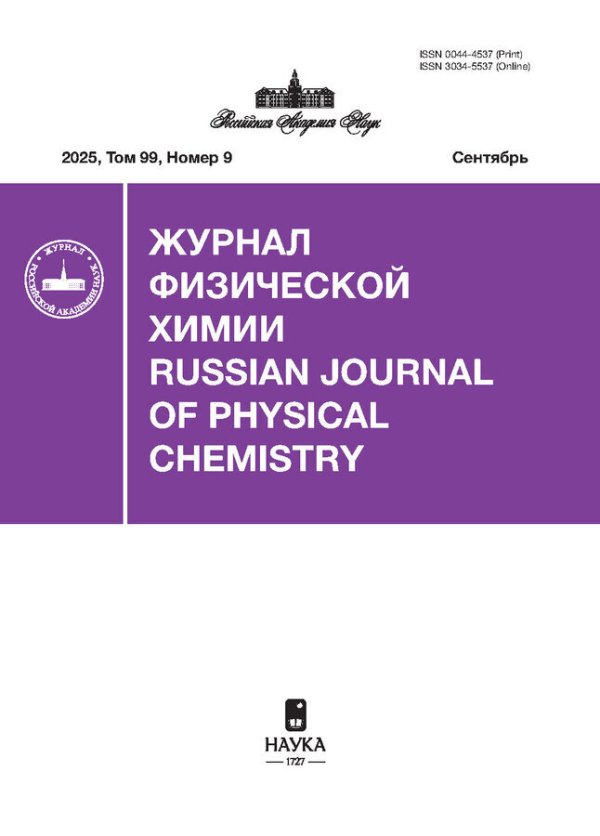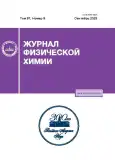Electron Capture Dissociation by Triclocarban Molecules
- Authors: Asfandiarov N.L.1, Rakhmeev R.G.1, Safronov A.M.1, Pshenichnyuk S.A.1
-
Affiliations:
- Institute of Molecular and Crystal Physics, Ufa Federal Research Center, Russian Academy of Sciences
- Issue: Vol 97, No 9 (2023)
- Pages: 1254-1261
- Section: STRUCTURE OF MATTER AND QUANTUM CHEMISTRY
- Submitted: 15.10.2023
- Published: 01.09.2023
- URL: https://journals.rcsi.science/0044-4537/article/view/136652
- DOI: https://doi.org/10.31857/S0044453723090029
- EDN: https://elibrary.ru/XJDAJR
- ID: 136652
Cite item
Full Text
Abstract
The formation and decay of molecular negative ions (MNIs) formed during resonant scattering of electrons by triclocarban molecules were studied by dissoiative electron attachment (DEA) spectroscopy. The most intense channel observed in the mass spectrum are MNIs formed at the thermal energy of trapped electrons with a lifetime relative to electron autodetachment of ~2800 μs. The experimental results were interpreted using CAM-B3LYP/6-311+G(d,p) calculations, which made it possible to reveal a number of important features of the geometry of molecular and fragment negative ions. Namely, the most stable geometry of MNIs is such that one of the chlorine atoms is coordinated with two hydrogen atoms of the structural element of urea. The charge on the chlorine atom is ~–0.7e–, which allows us to interpret this state as the result of the “roaming” of the chlorine atom in the MNI. According to calculations, the adiabatic electron affinity (EAa) of the triclocarban molecule is 1.66 eV. Evaluation of EAa in a simple Arrhenius approximation gives 1.2–1.4 eV. An analysis of the potential of the appearance of fragment ions with a C6H3Cl2NH2 structure made it possible to discover the noncovalent structure of these pseudo-MNIs, in which the chlorine atom is coordinated with two hydrogen atoms of the amino group.
About the authors
N. L. Asfandiarov
Institute of Molecular and Crystal Physics, Ufa Federal Research Center, Russian Academy of Sciences
Email: nail_asf@mail.ru
450075, Ufa, Russia
R. G. Rakhmeev
Institute of Molecular and Crystal Physics, Ufa Federal Research Center, Russian Academy of Sciences
Email: nail_asf@mail.ru
450075, Ufa, Russia
A. M. Safronov
Institute of Molecular and Crystal Physics, Ufa Federal Research Center, Russian Academy of Sciences
Email: nail_asf@mail.ru
450075, Ufa, Russia
S. A. Pshenichnyuk
Institute of Molecular and Crystal Physics, Ufa Federal Research Center, Russian Academy of Sciences
Author for correspondence.
Email: nail_asf@mail.ru
450075, Ufa, Russia
References
- Yun H., Liang B., Kong D., Li X., Wang A. // J. of Hazardous Materials. 2020. V. 387. P. 121944.
- Gregory N.L. // Nature. 1966. V. 212. P. 1460.
- Recknagel R.O., Glende Jr, E.A., Dolak J.A., Waller R.L. // Pharmacology & therapeutics. 1989. V. 43. P. 139.
- Schulz G.J. // Reviews of Modern Physics. 1973. V. 453. P. 423.
- Christophorou L.G. // Electron-molecule interactions and their applications.Orlando: Academic Press, 1984.
- Illenberger E., Momigny J. // Gaseous molecular ions. An introduction to elementary processes induced by ionization. Steinkopff Verlag Darmstadt. New York: Springer-Verlag, 1992.
- Pshenichnyuk S.A., Komolov A.S. // The J. of Phys. Chem.B. 2017. V. 121. P. 749.
- Pshenichnyuk S.A., Modelli A., Lazneva E.F., Komolov A.S. // Ibid. 2016. V. 120. P. 12098.
- Pshenichnyuk S.A., Modelli A., Asfandiarov N.L. et al. // Phys. Rev. Research. 2020. V. 2. P. 012030(R).
- Beynon J.H. Mass Spectrometry and Its Application to Organic Chemistry. Amsterdam: Elsevier, 1960.
- Kassem S., van Leeuwen T., Lubbe A.S. et al. // Chemical Society Reviews. 2017. V. 46. P. 2592.
- Baroncini M., Silvi S., Credi A. // Chemical reviews. 2019. V. 120. P. 200.
- Pshenichnyuk S.A., Asfandiarov N.L., Kukhta A.V. // Physical Review A. 2012. V. 86. P. 052710.
- Pshenichnyuk S.A., Asfandiarov N.L. // Phys.Chem. Chem. Phys. 2020. V. 22. P. 16150.
- Хвостенко В.И. Масс-спектрометрия отрицательных ионов в органической химии. М.: Наука, 1981.
- Пшеничнюк С.А., Асфандиаров Н.Л., Воробьев А.С., Матейчик Ш. // УФН. 2022. Т. 192. С. 177.
- Edelson D., Griffiths J.E., McAfee K.B. // J. Chem. Phys. 1962. V. 37. P. 917.
- Modelli A. // Phys. Chem. Chem. Phys. 2003. V. 5. P. 2923.
- Scheer A.M., Burrow P.D. // J. Phys. Chem. B. 2006. V. 110. P. 17751.
- Burrow P.D., Gallup G.A., Modelli A. // J. Phys. Chem. A. 200. V. 112. P. 4106.
- Илленбергер Е., Смирнов Б.М. // УФН. 1998. Т. 168. С. 731.
- Vorob’ev A.S., Pshenichnyuk S.A., Asfandiarov N.L., Nafikova E.P. // Tech. Phys. 2014. V. 59. P. 1277.
- Asfandiarov N.L., Pshenichnyuk S.A., Vorob’ev A.S. et al. // Rapid Communications in Mass Spectrometry. 2014. V. 28. P. 1580.
- Asfandiarov N.L., Pshenichnyuk S.A., Vorob’ev A.S. et al. // Rapid Communications in Mass Spectrometry. 2015. V. 29. P. 910.
- Макаров А.А., Малиновский А.Л., Рябов Е.А. // УФН. 2012. Т. 182. С. 1047.
- Chen E.S., Chen E.C.M. Rapid Commun Mass Spectrom. 2018. V. 32. P. 604.
- Asfandiarov N.L., Muftakhov M.V., Pshenichnyuk S.A., et al. // J. Chem. Phys. (2021). V. 155. P. 244302.
- Asfandiarov N.L., Muftakhov M.V., Safronov A.M. et al. // Technical Physics, 2022. V. 67. P. 1425.
- Burrow P.D., Modelli A., Jordan K.D. // Chem. Phys. Lett. 1986. V. 132. P. 441.
Supplementary files















